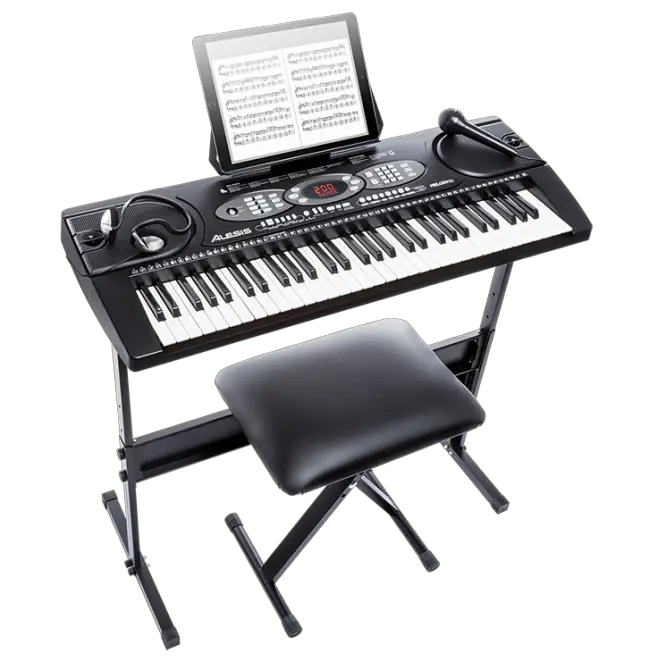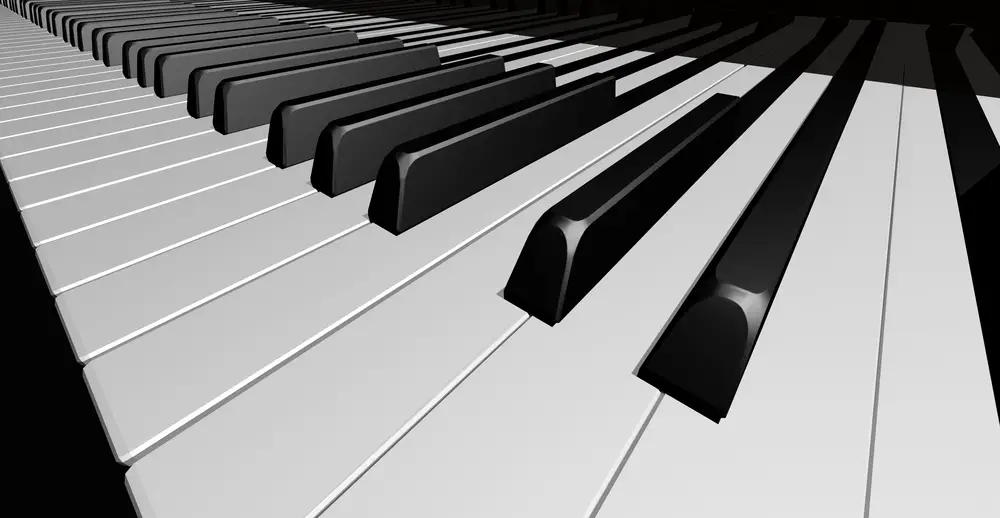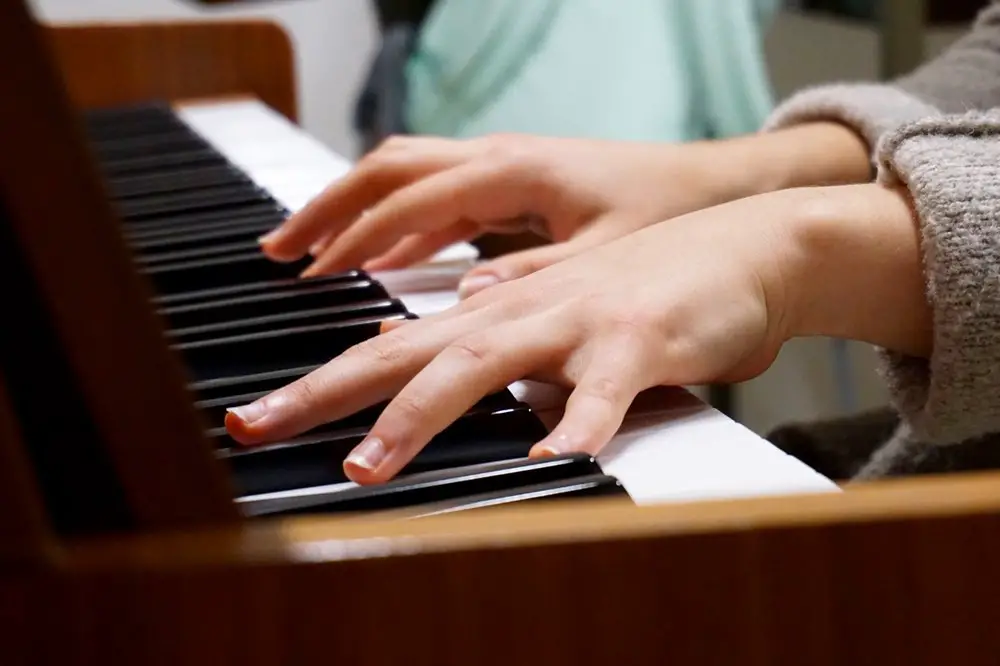
Alesis is known for their innovative drum kits and digital percussion instruments, specializing in using advanced technology to make high-performance digital instruments more affordable. They aren’t well known in the digital keyboard market, but the Alesis Melody 61 MKII has a great looking setup at an incredible price, so it’s worth taking a closer look.
Table of Contents
- Overview of the Alesis Melody 61 MKII
- Video Overview of Alesis Melody 61 MKII
- Alesis Melody 61 MKII’s and Specs
- Who is the Alesis Melody 61 MKII Most Suitable For?
- What’s Included with the Alesis Melody 61 MKII?
- Alesis Melody 61 MKII’s Features
- Pros & Cons of the Alesis Melody 61 MKII
- Alesis Melody 61 MKII Manual
- An Alternative Product to Consider
- Alesis Melody 61 MK2 Electric Keyboard Sound
- HSNtv’s Alesis Melody MKII Review
- Conclusion
Overview of the Alesis Melody 61 MKII

The Alesis Melody 61 MKII is designed for kids, and meant to appeal to slightly older kids who want a grown-up style piano keyboard setup, and don’t want to feel like they are playing with a toy. It’s a great way to introduce children to playing the piano, and has all the accessories and functions that will make any kid feel like a rock star.
The Alesis Melody 61 MKII is a 61-key keyboard with an astonishing 300 instrument voices and 300 built-in accompaniment rhythms. It has 40 demo songs, and comes complete with a keyboard stand, bench, music rest, headphones, and even a microphone. You can even record and play back your own songs through the keyboard. It has all the functions that a young aspiring musician is looking for.
Video Overview of Alesis Melody 61 MKII
Here’s a quick video for Alesis Melody 61 MKII:
Alesis Melody 61 MKII’s and Specs
| Specification | Description |
|---|---|
| Keys | 61 full size keys |
| Demo Songs | 40 built-in demo songs |
| Power | Can be AC powered or use 6 AA batteries |
| Split keyboard mode | Yes |
| Special Feature | Dual keyboard mode (other companies would call this “layer mode,” where you play two instruments with the same note) |
| Built-in instrument sounds | – 300 built-in instrument sounds, including sound effects – 300 built-in accompaniment rhythms |
| Accessories Included | – Comes with easy-to-assemble X-style keyboard stand – Comes with height-adjustable X-style bench – Comes with headphones – Comes with a music rest – Comes with an AC adaptor – Comes with a microphone – Includes 3 months of Skoove Premium online piano courses |
Who is the Alesis Melody 61 MKII Most Suitable For?

The Alesis Melody 61 MKII is perfect for young kids and pre-teens who have an interest in music. The huge array of instrument voices and sounds are fun to play with, the built-in rhythms and demo songs will have them playing full songs in minutes, and the microphone and headphones will make them feel like rock stars. It’s also capable of being powered by batteries, and is lightweight, so the keyboard can go with them to parties or picnics.
This is not a great keyboard for very young children. The keyboard itself, and the included stand and seat, are not particularly rugged in construction, and won’t withstand a lot of banging or wobbling.
The Alesis Melody 61 MKII is also not a great choice for more serious young music students. Most piano teachers would prefer that children practice on a weighted keyboard, to build finger strength and techniques that will transfer better to traditional pianos. It also doesn’t have any onboard lesson functions, and Skoove Online may not be the best piano instruction option for children. Finally, it doesn’t have any ability to connect to computers or digital devices, so you can’t choose other apps or online tools that may have better instruction.
With all these weaknesses, though, the Alesis Melody 61 MKII definitely looks cool and is fun to play, and is an extremely affordable digital keyboard. For kids the right age, it’s an excellent way to further their interest in music.
What’s Included with the Alesis Melody 61 MKII?
The Alesis Melody 61 MKII comes with:
Headphones

An X-style keyboard stand

An X-style keyboard stand

A microphone

A music rest

An AC adaptor

Altogether, it’s a complete digital keyboard setup, right out of the box.
Alesis Melody 61 MKII’s Features

| FEATURE | DESCRIPTION |
|---|---|
| Design | When it’s all set up, the Alesis Melody 61 MKII has a stylish look. The stand, bench, microphone, and headphones give the instrument a professional studio feel that is appealing. 61 keys are often used for beginner keyboards, because it’s an ample range of notes for beginners to learn with and produces a satisfying range of songs and musical styles, before upgrading to a full 88-key keyboard. It’s easily removed from the stand, and is compact and portable. The ability to power it with batteries make it easy to take anywhere, so your kids can perform and share their music. |
| Sound | It has a huge library of 300 instrument voices, some of them including fun and funny sound effects kids will love. It also has 300 auto-accompaniment rhythms, so you can start playing complete songs right away, with just the press of a button. The 40 built-in demo songs are fun to play and sing along with. |
| Skoove Premium | Skoove is an online piano education website that walks you step-by-step through the act of playing and reading music. Because the Alesis Melody 61 MKII doesn’t have online connectivity, you have to set up a nearby computer to access the website through your browser, and then allow your browser to “listen” to your piano playing through the computer’s microphone in order to evaluate and progress through lessons. |
| Skoove | Skoove shows you the correct hand positions and pauses lessons until you play the right note, giving you feedback and progressing you through the learning process. Skoove is an effective way to learn the piano, and a great way to try the service (although but the user experience and song selections aren’t particularly child-friendly, and may not appeal to short attention spans and encourage kids to practice. |
| Features | Dual keyboard mode allows you to play two instrument sounds at once, while the split keyboard allows you to play different instruments with each hand. Onboard recording and playback features allow kids to listen to and share their performances. |
Pros & Cons of the Alesis Melody 61 MKII
| PROS | CONS |
|---|---|
| 61 full size keys are plenty for learning and practicing, and gives kids effective practice on standard-sized keys | Can’t adjust the microphone volume independently of the instrument volume, and the microphone is loud |
| 300 built-in instrument sounds, including sound effects, and 300 built-in accompaniment rhythms give children a huge range of ways to explore, experiment, and express themselves with the keyboard | Instrument voices and sound isn’t great |
| 40 built-in demo songs are great for practice and learning what the possibilities are | No USB or digital connectivity |
| Dual keyboard mode (other companies would call this “layer mode” where you play two instruments with the same note) and split keyboard mode allow you to make the most of the number of instrument voices by playing two at once with each note, or playing two different instruments with each hand | |
| Record and playback functions are fun for kids, and a helpful learning tool so they can hear themselves progress. It’s also a great way for them to share their music with others, so they can show what they have learned | |
| It comes with an easy-to-assemble X-style keyboard stand and height adjustable x-style bench so you can set up a keyboard area and keep it off the kitchen table | |
| It comes with headphones, which are particularly necessary for parents, as it allows kids to enjoy their playing with the keyboard without disturbing anyone else | |
| It comes with 3 months of Skoove Premium online piano courses, which normally costs $13.33/month, and is a simple, easy way to learn and practice the piano using a web browser | |
| It comes with a microphone. This one may just as well be a “con” in some homes; the microphone volume can’t be adjusted independently of the master volume, and it is very loud. It’s a blessing for families with good singers, and most kids love it, but some parents find themselves hiding the microphone in the middle of the night |
Alesis Melody 61 MKII Manual
If you’d like to check out the nitty-gritty of the Alesis Meldoy 61 MKII, here’s a link to the model’s manual:
CLICK TO DOWNLOAD ALESIS MELODY 61 MKII MANUAL
An Alternative Product to Consider
The Alesis Melody 61 MKII is something more than a toy, but not quite an instrument. When considering alternatives, it’s natural to look at the sister model of this keyboard, the Alesis Melody 61. The two models look very superficially similar, and come with very similar accessories, so it comes down to a few crucial differences:

Alesis Melody 61 MKII
| – X-style keyboard stand |
| – Full-size keys |
| – 37.2 inches wide, weighs 8.7 pounds |
| – 300 instrument voices |
| – 300 accompaniment rhythms |
| – 40 demo songs |
| – 3 months online instruction with Skoove Premium |
Alesis Melody 61
| – Panel-style keyboard stand |
| – Compact keys |
| – 33.84 inches wide, weighs 6.87 pounds |
| – 200 instrument voices |
| – 128 accompaniment rhythms |
| – 10 demo songs |
| – 3 built-in instruction modes |
| – USB connectivity |
One would expect that a keyboard with USB is more expensive than one without; it’s a feature that many keyboard manufacturers attach a premium value to, despite the fact that the capability actually costs the manufacturer very little. However, the Alesis Melody 61 is so much more expensive than the Alesis Melody 61 that the cost difference is truly staggering.
The Alesis Melody 61 MKII is an excellent bargain for the purchase price. The Alesis Melody 61 simply is not; there are exceptional beginner keyboards in that price range that are far superior to this one.
For kids who really want to feel like a rock star, and for a digital keyboard with better sound, better construction, and a better learning experience, a great alternative to the Alesis Melody 61 MKII is the Hamzer 61-key Portable Keyboard. Like the Alesis Melody 61 MKII, the Hamzer 61 has:

| – 61 full-size keys |
| – Comes with a music stand |
| – Comes with a keyboard stand |
| – Comes with a keyboard stool |
| – Comes with headphones |
| – Comes with a microphone |
| – Comes with AC power adaptor |
| – Can be powered with 6 AA batteries |
| – Built-in recording and playback functions |
The Alesis Melody 61 MKII has some advantages over the Hamzer, because it has:
| – More instrument voices, at 300 vs 255 |
| – More onboard rhythms, with 300 vs. 255 |
| – More demonstration songs, with 40 vs 24 |
However, despite being virtually the same price as the Alesis Melody 61 MKII, the Hamzer is a much higher quality instrument, and has features the Alesis lacks, including:
| – 61 keyboard percussions |
| – Integrated learning system |
| – Advanced audio effects like chord timbre, vibrato, sustain, ensemble |
| – Advanced customization settings like program/edit rhythm, rhythm sync and fill-in, and tempo adjustment |
| – Improved sound sources and sound quality |
| – Importantly, on the Hamzer, you can adjust master volume and accompaniment volume independently |
| – The keyboard stand and stool are more ruggedly constructed and higher quality |
| – The keyboard itself is slightly smaller and lighter in weight |
While the Hamzer 61 is not a professional instrument, the better sound, higher quality construction of the keyboard and accessories, better onboard learning tools, and greater range of instrument options make it an overall better choice than the Alesis Melody 61 MKII, for just a few dollars more. The Hamzer is a good instrument for beginners of all ages, with a wider range of capabilities than the Alesis Melody 61 MKII.
Alesis Melody 61 MK2 Electric Keyboard Sound
HSNtv’s Alesis Melody MKII Review
Conclusion
While Alesis continues to make groundbreaking drums and percussion instruments, the Alesis Melody 61 MKII isn’t an impressive entry into the competitive digital keyboard market. With affordable options from legendary piano brands like Casio, Roland, and Yamaha, and a feature set that even a simple Hamzer can beat, the Alesis Melody 61 MKII has a way to go.
It also has the advanced digital features that acoustic pianos don’t have, including a wide selection of tones, rhythms, polyphony, and even simple volume controls to make it easy to live with. Recording and playback, transpose, and split keyboard functions offer a range of possibilities and capabilities that invite learning and exploration, as well as affording unique opportunities for growth and expression.

Most keyboards offer a fraction of the features at more than double the cost. This powerful, versatile, handsome digital console keyboard simply cannot be beat in its price range, and is a fantastic choice for piano lovers everywhere.







